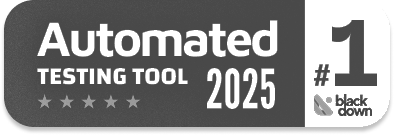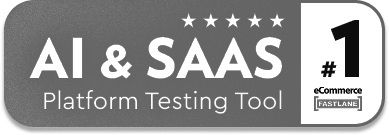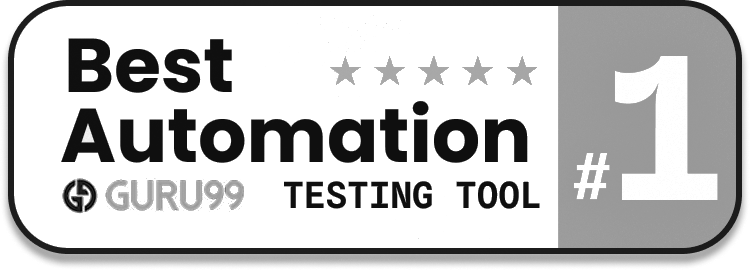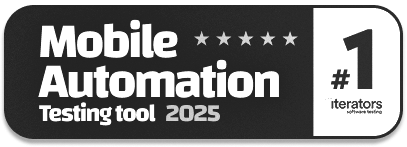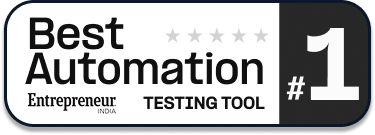What is Testing Center of Excellence (TCoE)
|
|
Software is the language of business in the new digital age. All the transactions, the customer touchpoints, and the competitive advantages now rely on the technology performance, which in turn relies on quality. However, with the increased complexity of systems, the problem of ensuring a consistent, scalable, and intelligent quality assurance across various technologies and teams becomes more challenging. Conventional project-based testing frameworks, despite their success in small silos, are not able to maintain enterprise-level agility and consistency.

Move to the Testing Center of Excellence (TCoE): a strategic model that turns testing into a business operation with business-wide capability. A TCoE is not a department or a team of testers. It is a governance and innovation center that centralizes QA best practices, standardized processes, integrated tools, expertise development, and testing alignment with business goals. It makes software testing a strategic differentiator and enabler of transformation, speed, and confidence.
| Key Takeaways: |
|---|
|
Understanding TCoE
A TCoE signifies an organization’s commitment to structured, scalable, and clever quality assurance. It is the central component that combines test standards, procedures, tools, and knowledge in all the teams. It converts QA from a project activity to a business strategic asset. Through institutionalization of best practices and innovation, a TCoE ensures there is no disconnection between software quality being delivered and enterprise goals and digital transformation initiatives.
Testing Center of Excellence (TCoE) Definition
A Testing Center of Excellence (TCoE) is a centralized model that regulates, controls, and streamlines all testing processes in an organization. It sets common standards, procedures, tools, and measures of testing, so that all projects follow common principles of quality.
A TCoE is, at its core, a representation of three philosophies:
- Knowledge and expertise centralization – to remove redundancy and inconsistency.
- Normalization of process and tools – to obtain predictable and measurable results.
- Constant change and innovation – to transform quality into a living practice.
A TCoE does not substitute testing teams; it empowers them by giving them structures, direction, and control. It is the brain and nervous system of quality throughout the enterprise.
From Fragmented Testing to Unified Excellence
In the traditional model, testing is distributed among projects and teams, which results in duplication, unequal skill levels, and inconsistent standards. The testing process is reinvented in each project, leading to inefficiencies and gaps. This is solved by a TCoE, which establishes a single testing ecosystem. It is the main centre of:
- Methodology and governance.
- Selection and integration of tools.
- Reusable asset libraries.
- Continuous improvement, metrics, and KPIs.
- Training and development of skills.
To the point, it makes testing a proactive discipline, rather than a reactive one, which is data-driven, automated, and excellent. Unified automation platforms like testRigor help eliminate fragmented testing practices by creating reusable test assets across multiple projects and environments. Its AI-driven test execution and self-healing capabilities ensure consistency and reduce rework, directly supporting the TCoE’s mission to deliver predictable and high-quality results across teams. Read more on AI-Based Self-Healing for Test Automation.
Purpose and Value of a TCoE
A TCoE, when done successfully turns software testing from being a support to a strategic asset in supporting business success. This division exists to create standards in quality, through re-use and automation and connecting testing objectives to the enterprise. A TCoE incorporates governance, scalability, and innovation into QA resulting in measurable value on speed, reliability, and trust from customers.
Strategic Objectives
- Consistency: Standard report formats and documentation methods to provide consistency in testing across the enterprise, delivering steady quality results.
- Efficiency: Enables optimum reusability of test assets, data, and automation scripts to minimize redundancy and overall testing time.
- Scalability: Allows us to easily scale testing resources and capabilities across projects, technologies, and global teams.
- Governance: Guarantees adherence to the policies, imposes measurable metrics, and aligns testing objectives to underlying marketing business goals.
- Innovation: Enhances the overall quality ecosystem by enabling AI, predictive analytics, and self-healing automation.
Why Enterprises Adopt a TCoE
Organizations that have adopted the digital transformation are under constant pressure to be faster, safer, and smarter. The TCoE makes them the operational backbone of quality: the ability to be agile without losing control, fast without losing accuracy, and automated without chaos. It makes QA a value creator: brand trust, customer experience, and operational resilience. Read more about What is WAgile? Understanding the Hybrid Waterfall-Agile Approach.
The Structural Foundation of a TCoE
The success of a Testing Center of Excellence (TCoE) hinges on the effective fusion of people, process, and technology. These three pillars are complemented by each other to create a strong quality ecosystem that delivers on consistency, efficiency, and innovation for the organization. With the right mix of human intelligence, standardized processes, and tools, a TCoE turns testing into a strategic, data-driven process that enables business success.
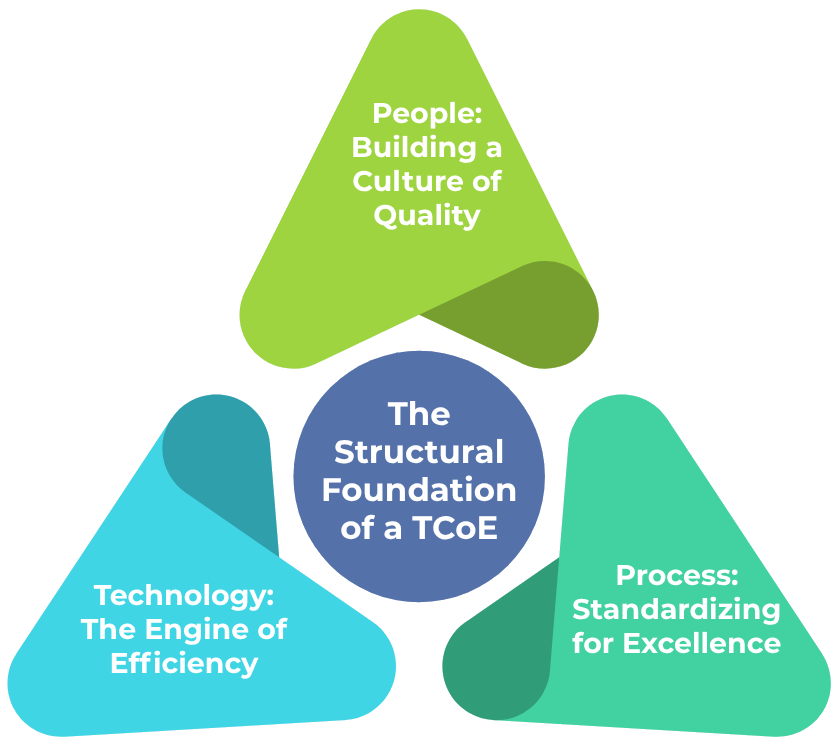
People: Building a Culture of Quality
The strength of a TCoE is its human resources, highly skilled professionals with an approach to excellence. Key roles typically include:
- Test Architects: Establish holistic test strategies, frameworks, and structures to ensure alignment with business and technical objectives.
- Automation Engineers: Develop automated solutions that are intelligent enough to test robustly, yet can save time in testing and enable more accuracy. Read SDET vs. Test Automation Engineer: Differences.
- Quality Analysts: Monitoring, measuring, and controlling quality metrics, compliance measurements, and process effectiveness.
- Performance and Security Specialists: Ensure the stability, scalability, and security of our system by creating large-scale performance tests and performing vulnerability assessments.
- Innovation Leaders: Investigate and integrate new technologies, including AI, ML, and advanced methods for QA to enable continuous improvement and innovative business models.
A TCoE invests in skills, mentorship, and certification. It also turns testers into quality engineers and gives them the power to impact architecture, performance, and user experience.
Process: Standardizing for Excellence
A TCoE standardizes all the QA processes, such as test design, test execution, test reporting, and test improvement. It guarantees compliance, repeatability, and transparency. The elements of core processes are:
- Cohesive QA Strategy: Combines Agile, DevOps, and traditional testing disciplines to have a single quality procedure regardless of delivery models.
- Governance Policies: Establishes proper roles, approval processes, and escalation mechanisms to ensure accountability and control during the course of QA.
- Metrics Framework: Creates measurable metrics, including coverage, defect rates, automation ROI, and cycle time to measure and optimize performance.
- Continuous Feedback Loop: Aim to learn from every release and keep raising the bar over time, increasing the organization’s quality maturity.
Standardized processes make sure that quality is not a project-based concept but rather a system-based concept.
Technology: The Engine of Efficiency
A TCoE is a force multiplier in technology. Contemporary testing is unable to survive without sound automation, AI, and analytics. A mature TCoE invests in:
- Unified automation infrastructures, such as testRigor.
- Intelligent predictive tools that identify defect trends and test failures.
- Constant integration pipelines with 24/7 automated validation.
- Real-time release-readiness analytics.
Technology enables the TCoE to shift to intelligence, not automation, i.e., not running tests but predicting the results.
How a TCoE Operates
A Testing Center of Excellence (TCoE) operates through a balance of centralized strategy and decentralized execution, ensuring both governance and flexibility across projects. It defines the overarching testing standards, tools, and metrics while empowering individual teams to implement them within their specific contexts. Through continuous feedback, data-driven insights, and collaboration, the TCoE evolves into a dynamic system that drives enterprise-wide quality improvement.
Centralized Strategy, Distributed Execution
The playbook is defined by the TCoE and implemented by project teams. This mixed system guarantees equilibrium between independence and control. The TCoE sets standards, tools, and KPIs. Individual projects are implemented in those structures, and they are adapted accordingly. Feedback cycles are sustained to provide insights to the TCoE to evolve.
Data-Driven Decision-Making
The TCoE uses analytics to quantify quality performance, release, team, and system. The decisions regarding the test scope, the allocation of resources, and the evaluation of risks are not made on an intuitive basis but on the basis of the data.
Continuous Learning Ecosystem
One of the characteristics of a mature TCoE is the learning capability. Each flaw, each achievement, each tendency adds to a constantly growing store of knowledge. This learning loop will make the TCoE smarter with each sprint.
Key Benefits of Establishing a TCoE
Establishing a Testing Center of Excellence (TCoE) delivers clear benefits in terms of quality, efficiency, and business alignment for the enterprise. It introduces consistency, improves efficiency, and encourages a spirit of innovation, that way testing becomes faster, smarter, and reliable. By transforming QA into a strategic enabler, a TCoE helps instill customer confidence while also improving time-to-market and promoting sustained operational prowess.
- Predictable Quality: Standardized methodologies remove testing result variation, bringing consistency between teams, regions, and technologies.
- Faster Time-to-Market: Reusability and automation minimize the time required in testing cycles so that releases can be made faster without compromising on depth. Read: The Impact of Test Automation on Time to Market.
- Cost Efficiency: Similar structures, resources, and tools reduce redundancy, and economies of scale are achieved.
- Measurable Governance: By having transparent KPIs and dashboards, executives can see real-time quality metrics and ROI.
- Continuous Innovation: The TCoE, through its institutionalization of R&D into the QA process, will be an incubator of emerging testing technologies such as AI, blockchain validation, and self-healing tests.
- Cultural Shift: Probably the least obvious advantage: a TCoE will foster a culture of ownership and excellence, in which quality is everyone’s concern, not limited to the role of QA.
Establishing a Testing Center of Excellence
Developing a Testing Center of Excellence (TCoE) is the strategic direction that makes quality assurance a capability throughout the enterprise. It involves a programmatic approach that includes establishing the vision, standardizing processes, developing talent, and integrating technology. By design and constant improvement, companies can create a scalable, data-oriented, and business-value TCoE that ensures reliable quality to the business.
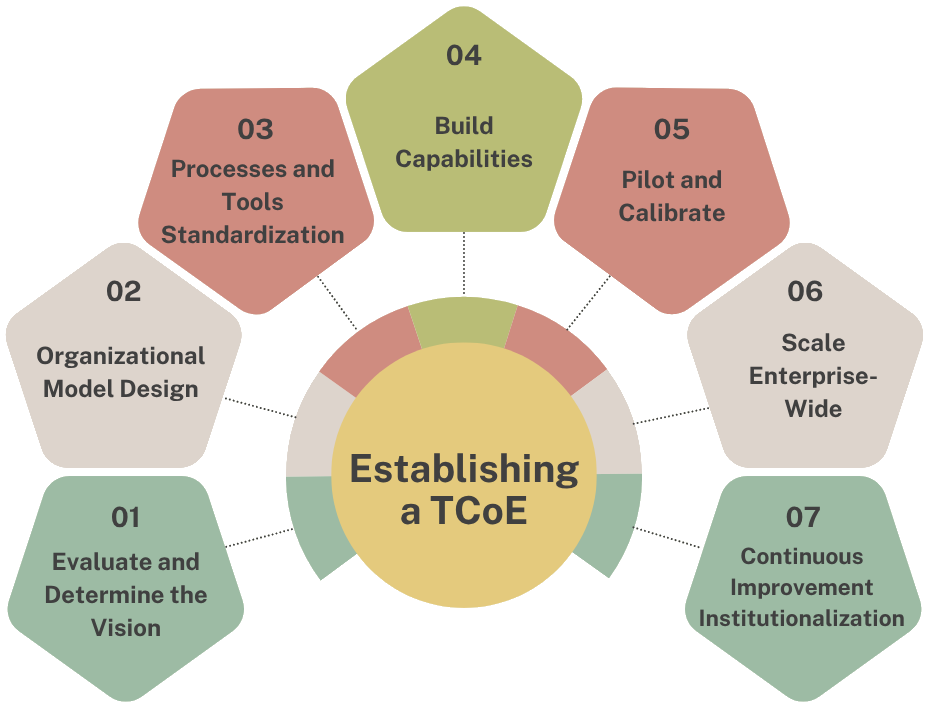
- Step 1: Evaluate and Determine the Vision: Assess the level of current QA maturity: tools, processes, level of automation, skillsets, and business goal alignment. Establish an excellence vision statement and get leadership sponsorship.
- Step 2: Organizational Model Design: Determine the structure (centralized, federated, and hybrid) in regard to scale and business requirements. Delegate leadership and levels of governance.
- Step 3: Processes and Tools Standardization: Standardization of templates, assets, and automation. Bring together tools from CI/CD pipelines to create a comprehensive testing ecosystem.
- Step 4: Build Capabilities: Recruit and develop the appropriate talent, create automation, performance, and security centers of expertise. Develop mentoring to develop internal QA leaders.
- Step 5: Pilot and Calibrate: Start small, choose a couple of projects and prove frameworks, metrics, and collaboration models. Take lessons learned to streamline the TCoE structure.
- Step 6: Scale Enterprise-wide: Once pilot validation is done, extend to all business units. Introduce governance dashboards based on KPI and create a feedback mechanism to make it agile.
- Step 7: Continuous Improvement Institutionalization: Transform the processes into dynamic learning. Introduce data-driven perspectives and AI-based insights to make the TCoE self-adaptive.
TCoE and Business Transformation
A Testing Center of Excellence (TCoE) is indispensable in facilitating business transformation through the adaptation of quality assurance with corporate strategy. It ensures that testing increasingly underpins and drives digital initiatives with governance, agility, and innovation.
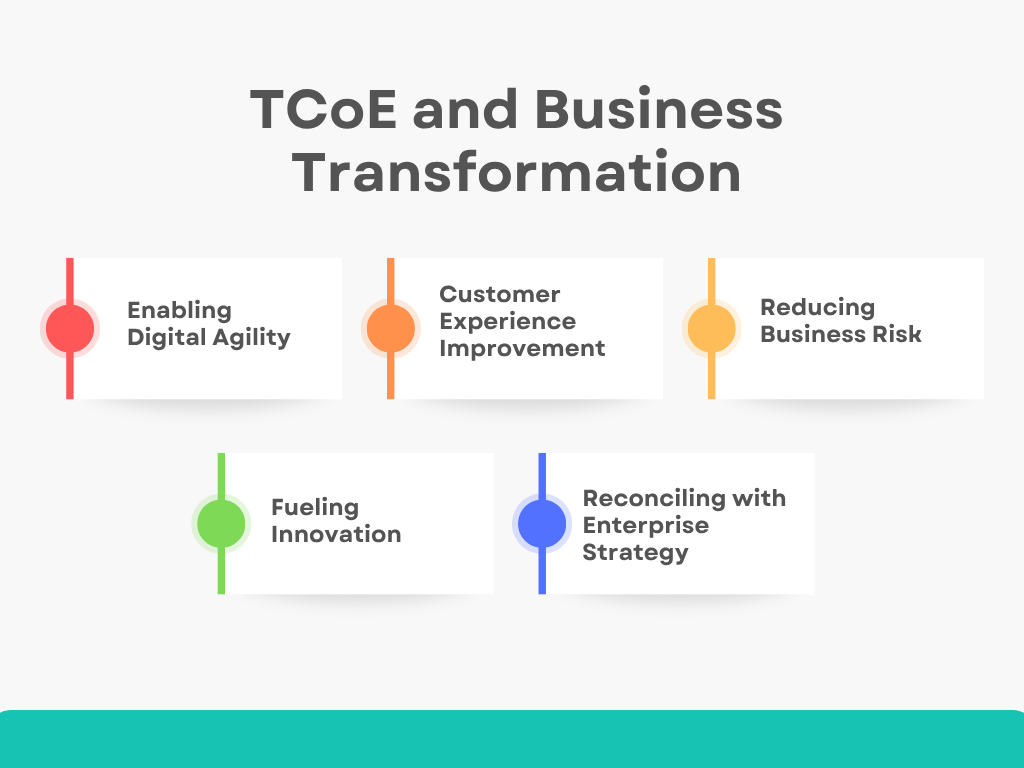
- Enabling Digital Agility: The contemporary businesses work within the rapid-release cycles that are propelled by DevOps and Agile. A TCoE offers stability in speed by creating governance structures where agility does not undermine integrity.
- Customer Experience Improvement: Reliability and performance are important in customer satisfaction. A TCoE facilitates customer-focused testing, which makes products not only functional but also provide a consistent and intuitive experience.
- Reducing Business Risk: The TCoE predicts possible areas of failure, preventing production failures and business expenses through predictive analytics and test intelligence.
- Fueling Innovation: The TCoE enables more time to be spent on creative problem-solving by consolidating expertise and eliminating unnecessary tasks by teams, which leads to innovation in product design and delivery.
- Reconciling with Enterprise Strategy: A TCoE makes sure that testing KPIs are consistent with enterprise KPIs. As defect leakage, time-to-market, and automation ROI are directly related to business results like retaining customers and increasing revenue.
By adopting testRigor within a TCoE, organizations can significantly enhance digital agility. The platform’s natural-language testing approach democratizes automation, empowering cross-functional teams to participate in testing. This democratization fosters faster validation, continuous feedback, and innovation across the product lifecycle. Read about Natural Language Processing for Software Testing.
TCoE Maturity Model
The TCoE maturity model reflects the evolutionary states that an organization progresses through on the path to testing excellence. It shows how quality assurance work progresses from ad-hoc, project-based actions to an entirely intelligent, data-related, and automatically improved quality system. This model enables organizations to evaluate their current state, recognize gaps, and move strategically towards pervasive quality improvement across the enterprise.
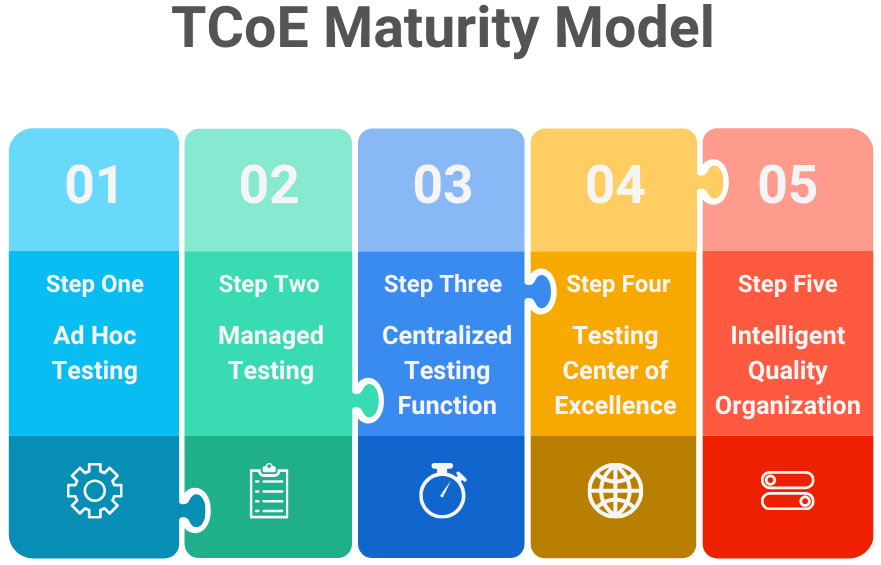
- Stage 1: Ad Hoc Testing: Testing is project-specific, unstructured, and reactive, with a variety of tools.
- Stage 2: Managed Testing: A certain standardization starts. Processes are localized, and documentation, planning, and defect tracking are formalized.
- Stage 3: Centralized Testing Function: There is an emergence of a centralized QA team. Common tools and best practices are presented, and automation and analytics remain minimal.
- Stage 4: Testing Center of Excellence: The organization creates a fully functioning TCoE, central governance, common assets, automation frameworks, and enterprise-wide metrics, creating uniform results.
- Stage 5: Intelligent Quality Organization: The TCoE is adaptive and autonomous with the help of AI, predictive analytics, and self-learning systems. AI-powered platforms like testRigor represent the evolution of test automation within a TCoE. With predictive analytics, self-healing capabilities, and autonomous test generation, it supports continuous quality improvement and transforms testing into a living, intelligent ecosystem. Read about What is Autonomous Testing?
The Human Dimension
Finally, a TCoE is successful due to the individuals behind it. Standardizing processes and tools is possible, and excellence only flourishes when teams have faith in it. A mature TCoE invests in:
- Ongoing training programs.
- Knowledge-sharing platforms.
- Innovation and quality leadership reward systems.
- Cross-functional collaboration workshops.
Once quality is embedded in the DNA of the company, the TCoE ceases to be a matter of structure; it is culture.
Conclusion
A Testing Center of Excellence is not only a governance model, but a strategic transformation framework. It concentrates intelligence, practices, and aligns software quality with business excellence. A TCoE will guarantee that quality is a predictable, scalable, and measurable enterprise-wide competency by integrating people, process, and technology under a single roof.
A TCoE in its purest form is not about testing software; it is about engineering trust, the trust that all releases, all interactions, and all experiences will be excellent.
| Achieve More Than 90% Test Automation | |
| Step by Step Walkthroughs and Help | |
| 14 Day Free Trial, Cancel Anytime |



